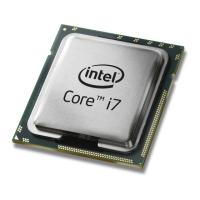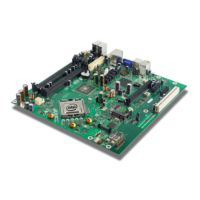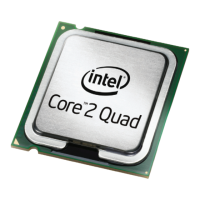Technologies
42 Datasheet, Volume 1
3.4.2 Intel
®
Turbo Boost Technology Graphics Frequency
The graphics render frequency is selected dynamically based on graphics workload
demand as permitted by the processor turbo control. The processor can optimize both
processor and Processor Graphics performance through power sharing. The processor
cores and the processor graphics core share a package power limit. If the graphics core
is not consuming enough power to reach the package power limit, the cores can
increase frequency to take advantage of the unused thermal power headroom. The
opposite can happen when the processor cores are not consuming enough power to
reach the package power limit. For the Processor Graphics, this could mean an increase
in the render core frequency (above its rated frequency) and increased graphics
performance. Both the processor core(s) and the graphics render core can increase
frequency higher than possible without power sharing.
Note: Processor utilization of turbo graphic frequencies requires that the Intel Graphics driver
to be properly installed. Turbo graphic frequencies are not dependent on the operating
system processor P-state requests and may turbo while the processor is in any
processor P-states.
3.5 Intel
®
Advanced Vector Extensions (AVX)
Intel
®
Advanced Vector Extensions (AVX) is the latest expansion of the Intel instruction
set. It extends the Intel
®
Streaming SIMD Extensions (SSE) from 128-bit vectors into
256-bit vectors. Intel AVX addresses the continued need for vector floating-point
performance in mainstream scientific and engineering numerical applications, visual
processing, recognition, data-mining/synthesis, gaming, physics, cryptography and
other areas of applications. The enhancement in Intel AVX allows for improved
performance due to wider vectors, new extensible syntax, and rich functionality
including the ability to better manage, rearrange, and sort data. For more information
on Intel AVX, see http://www.intel.com/software/avx
3.6 Advanced Encryption Standard New Instructions
(AES-NI)
The processor supports Advanced Encryption Standard New Instructions (AES-NI) that
are a set of Single Instruction Multiple Data (SIMD) instructions that enable fast and
secure data encryption and decryption based on the Advanced Encryption Standard
(AES). AES-NI are valuable for a wide range of cryptographic applications; such as,
applications that perform bulk encryption/decryption, authentication, random number
generation, and authenticated encryption. AES is broadly accepted as the standard for
both government and industry applications, and is widely deployed in various protocols.
AES-NI consists of six Intel
®
SSE instructions. Four instructions, AESENC,
AESENCLAST, AESDEC, and AESDELAST facilitate high performance AES encryption and
decryption. The other two, AESIMC and AESKEYGENASSIST, support the AES key
expansion procedure. Together, these instructions provide a full hardware for
supporting AES, offering security, high performance, and a great deal of flexibility.

